If you’re running an Ecommerce business, you’re likely aware of the crucial role that SEO plays in driving traffic and sales. However, despite its importance, SEO can be a complex and ever-evolving field that can be challenging to navigate without the right knowledge and approach.
In this article, we’ll dive into the world of Ecommerce SEO and provide you with the insights and strategies you need to optimize your site for search engines effectively. Whether you’re new to SEO or looking to take your eCommerce business to the next level, this guide will equip you with the tools you need to succeed in the competitive world of online retail.
SEO is a highly effective way to increase organic search traffic, which is why many people seek to utilize it. However, a significant number of individuals lack a clear understanding of how SEO works.
To maximize the benefits of SEO, it’s crucial to focus on driving search traffic from keywords that have a higher likelihood of converting into sales. While there are many SEO strategies out there, it’s essential to prioritize those that are most likely to yield profitable results. Ultimately, the goal of using SEO for your online business should be to generate revenue. Rather than spending excessive amounts of time researching various SEO tactics, prioritize those that are most likely to help you achieve your financial objectives.
Research opportunities
Your opportunities depend on the nature of your product.
There are three parts of your online store that you can drive organic traffic:
- Product pages
- Category pages
- Content pages (blog, support, forum, and FAQ)
Ranking for product pages: Before investing time, effort, and money on boosting your organic traffic, you need to answer the following questions.
How long will you be selling certain products?
Do people actually search for your product online?
It takes a lot of time and effort to improve your SEO rankings. So you want to invest in lasting pages to reap the benefits.
If you have products with limited inventory or a site that sells innovative products that people don’t even know exist (see Tile), then you shouldn’t waste time and energy trying to rank your product page.

Ranking for category pages: Category (and sub category) pages are great places to invest your SEO efforts. Most online entrepreneurs never change these pages.
For example, if I’m selling women’s shoes, the style and products will constantly change. However, the type of shoes (heels, sandals, boots, etc.) will be the same. Since I am always going to be selling heels, I will want to rank for the heels category page.
Ranking content: Content is surprisingly underutilized in e-commerce strategies. Optimizing your content for SEO is the best way to scale your organic traffic.
High quality content is especially valuable for stores with innovative, artisan, and B2B products. The customer needs to be educated, so content will help overcome their skepticism and encourage them to buy.
however, content might not be as effective with flash sell sites or sites that sell common novelty products.
For example, let’s assume I’m running a store that resells BB guns. There isn’t much information people would search for online except for BB gun types, BB gun reviews, and brand comparisons. BB guns are novelty products that most people aren’t likely to search for.
You need to find out if there is enough valuable information for prospective customers before trying to optimize your content for the search engines.
Keyword Research
Keyword research is a very important part of any SEO strategy. You need to understand who your ideal customers are and their purchasing behavior to conduct it properly.
You will need to understand how they research new products and how they go about making purchase decisions.
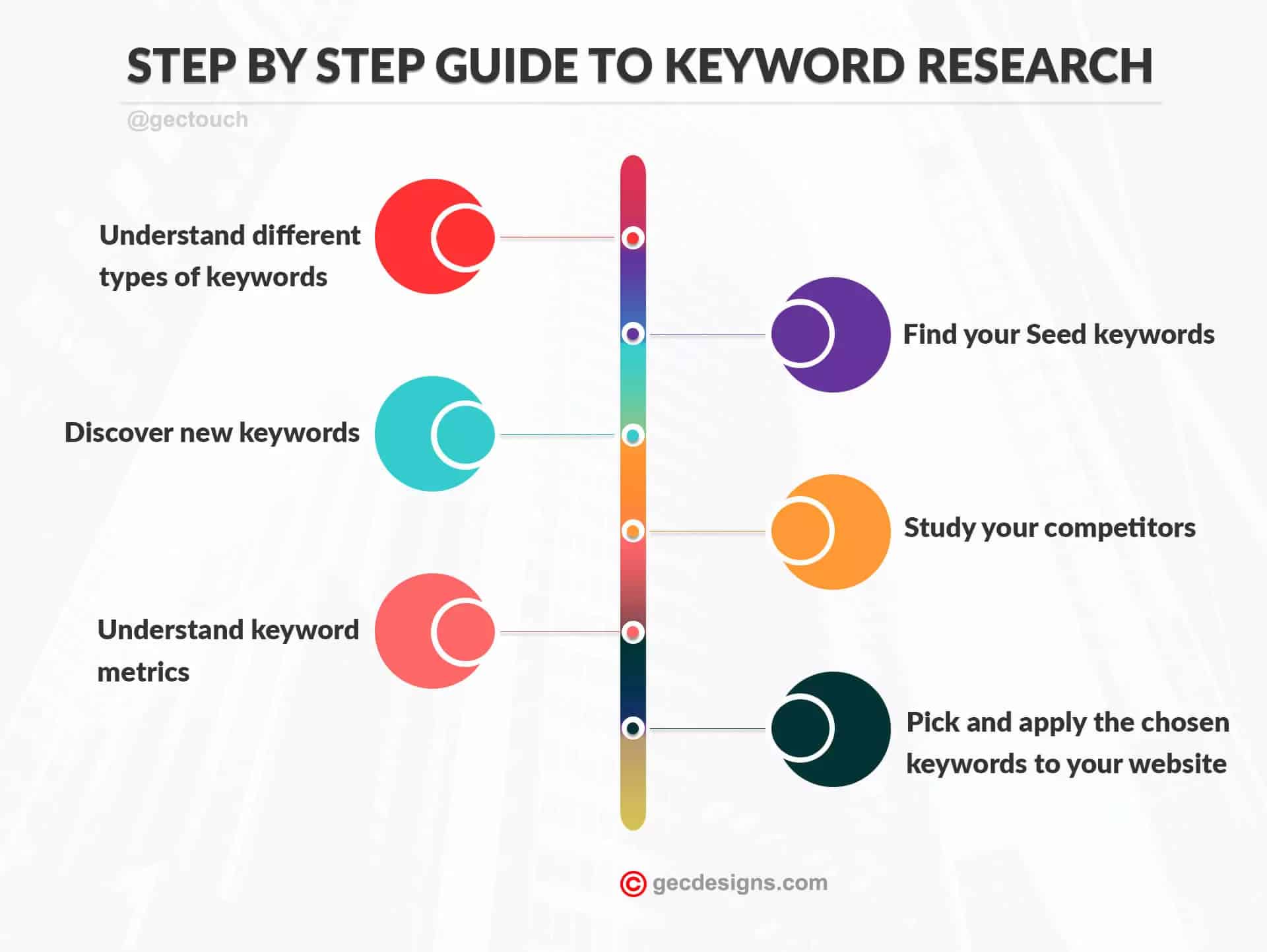
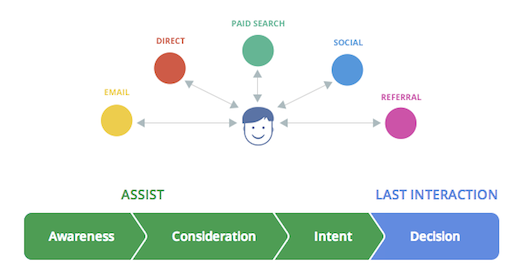

Next, categorize your keywords into two categories: keywords for commercial intent and for providing information. Informational intent keywords will be used in your content. Commercial intend keywords will be used on product and category pages (or any pages with product-related information).
For example, if you are selling organic pet products, your ideal customers would be health-conscious pet owners.
Here is an overview of the process a customer would follow
Step 1: Research information to solve their problems (this is where you can create great content to capture these keyword opportunities) Example search queries: “How do I keep my dog healthy?” – information intent “Are antibiotics bad for cats?” – information intent “What type of diet should I give overweight medium size dogs” – information intent Step 2: Weigh options on the best solution. Example search queries: “Should I make the meals myself or buy organic dogs food?” – information intent “How to make a balanced organic diet for medium size dogs?” – information intent “Should I run my dog twice a day or just buy a doggy treadmill?” – information intent from brands for considering buying decision. Example search queries: “Organix vs Nature’s Variety Instinct” – commercial intent “ABO gear happy habitat cat tent review” – commercial intent “Organic dog food” – commercial intent “Organic hamster nesting material” – commercial intent Step 4: Look at category pages to see what products are available Example search queries: “Nature’s Variety Instinct coupon” – commercial intent “PetFlow coupon code” – commercial intent “Nature’s Variety Instinct Raw Boost Grain Free Dog Food” – commercial intentStep 4: Look at individual products, deals and coupons
Example search queries: “Nature’s Variety Instinct coupon” – commercial intent “PetFlow coupon code” – commercial intent “Nature’s Variety Instinct Raw Boost Grain Free Dog Food” – commercial intentContinue looking for new keyword ideas for your customer profile and buying cycle. Finally, prioritize your keywords worth optimizing for based on the following:
- Keyword competition
- Average monthly search
- Customer relevance
Competitor Research
Before we get into the nitty-gritty, let’s clarify what types of competitors we are looking for. You want to review sites that are competing with you on search engine, products, or both.
A site is definitely a competitor if it’s both offering similar products and competing for similar keywords in the search engines.
If a site is competing on search engine only, but not products then it counts as a competitor. Sites receiving traffic from keywords you’re targeting are competing with you for visibility.
For example. I’m looking for competitors who are ranking for informational keywords about pet care and came across the blog PetMD. Even though PetMD is a blog that doesn’t sell any pet products, it has loads of content ranking for the keywords that attract my potential customers.
When a site is only competing on products, but not on search engines then it’s not really a competitor from a SEO perspective. They are a competitor in the traditional sense, but I don’t have to worry as much about competing with them for organic traffic.
The best way to come up with a strategy is to take a peek at your competitors. There are 3 things you need to look at.
Part 1 – What keywords are they going after and are currently ranking for?
Looking at the keywords your competitors are ranking for help you come up with profitable keyword opportunities. It can also inspire new ideas you wouldn’t have thought of otherwise. Most importantly you’ll get a good idea of what works for your competitors and what doesn’t, which keeps you from wasting money ranking for worthless keywords.
You can use SEMRush to research your competitor’s rankings.
Part 2 – Which sites are link to them?
Your competitors backlink profile can give you insights to what type of sites are linking to them, which can helps you come up with a link building strategy for your own site. Ahrefs backlink checker is a great tool for analyzing backlinks.
Part 3 – Are they producing content? What type of content is getting ranked for the keywords you are looking for and attracting social engagement?
BuzzSumo is an awesome free tool that helps you analyze which content in your niche is getting the most social engagement.
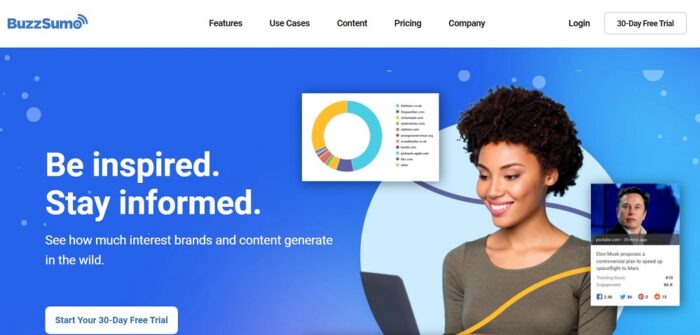
Setup proper tracking
You need to track all the crucial metrics to know what works so you can invest solely in strategies that provide results.
Here is a list of essential metrics you’ll need to track for your SEO campaign and the tools you can use to do so:
Target keyword rankings: You will want to track keywords that provide a high ROI. You will want to focus on the best keywords from your research, as well as opportunities you found through Google Webmaster Tools and Google Analytics.
One of my favorite keyword-tracking tools is Ranktracker. I would also recommend Moz if you are looking for a more comprehensive solution.
Backlinks: Backlinks can make or break your SEO efforts. It’s crucial to find out who links to you and try to have a clean backlink profile.
Here are the more specific metrics and elements you need to keep an eye on for backlinks:
- Number of new backlinks gained
- Number of backlinks lost
- Number of referring domains
- Top URLs with the most referring domains
- Backlink quality
You can use Ahrefs for backlink analysis.
Anchor Text Distribution: Unnatural anchor text distribution is a huge red flag when it comes to Google penalties. So it’s important to keep an eye on this.
Organic traffic: This is one of the most important metrics. The whole point of getting ranked for keywords is so you can get Organic Traffic, which will convert into revenue. When analyzing organic traffic, separate it into Branded and Non-branded organic traffic. Here is why this is important:
Branded organic traffic: People typing the name of your store have already heard about your brand. This metric basically tells you how well your branding and word of mouth is doing, such as PR and social media.
Non-branded organic traffic: This is where SEO will really pay off. When people type in a keyword and stumble on your site, you are getting a new visitor who can potentially become your customer.
Traffic per keyword: This is very important because you need to know which keywords are getting you traffic, so you know which keywords to invest your efforts. You can get this data from Google Webmaster Tools. For more integrated usage, connect your Google Analytics and Google Webmaster Tools so you can access information.
Conversions from organic traffic: Tracking conversions is one of the most important metrics (if not the most important). It will tell you a lot about the quality of your organic traffic and whether your conversion optimization efforts are working. You need set up Goal Tracking to track conversions in Google Analytics.
Technical Optimization and Fixing Errors
Now that you’ve got your game plan ready and set up your tracking, it’s time to set up a great SEO foundation.
The first thing we need to address is proper site structure.
Having a great site structure will:
- Amplify your link building efforts to pass link juice properly.
- Properly theme your product and content categories for internal linking.
- Improve your site’s usability to improve your sales conversions.
A great site structure needs to get the user from the homepage to a product page with little effort, while also making sure all content and product pages are categorized properly.
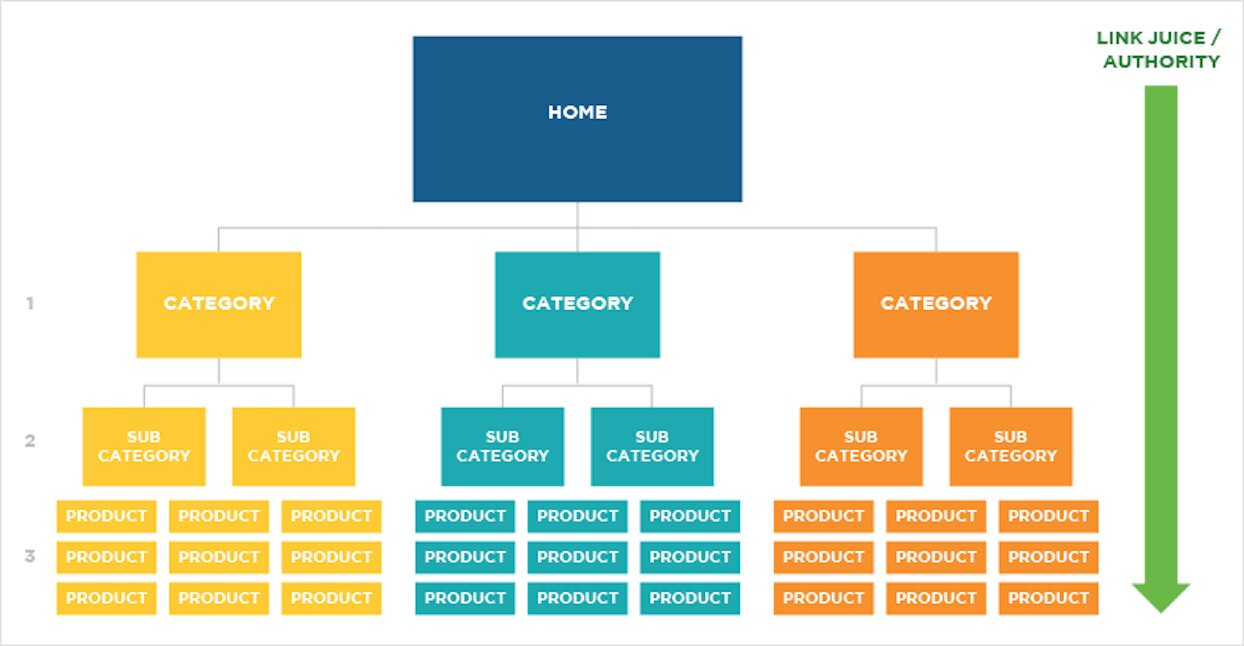
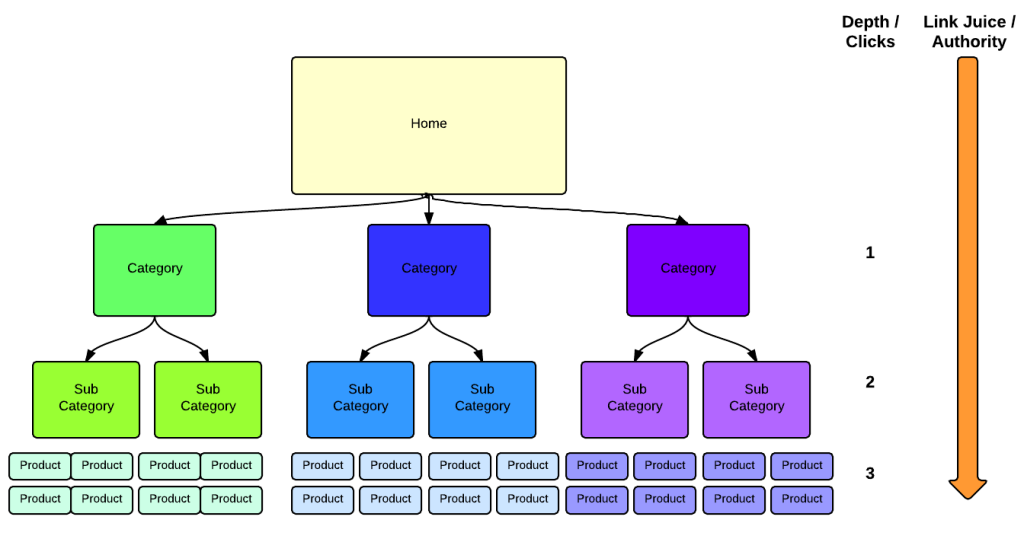

Once your structure is set up, you will not be able to change your URL structure.
Internal Linking
Note: When we are talking about internal linking, we are talking about linking to another page within the same website.
Having great internal linking structure allows you to target keywords, flow SEO value (aka “link juice”), and improve indexation.
There are two main elements to watch out for when you’re internally linking your pages:
Page theme relevance: When you are linking to another page, you have to make sure you are linking product, content, and categories pages with a similar theme (which is why you need a good link structure).
The main reason is to avoid theme bleeding, which became even more important after the most recent “Google Helpful Content” Update, which penalizes topical authority, which can be caused by inappropriately linking to other pages on your site.
Anchor text diversity: Anchor text was heavily abused as many sites used exact keywords. The Google Penguin Update ruthlessly penalized sites that overused unnatural anchor texts.
One way to address this is to rotate your anchor text, so you can internally link while keeping a natural ratio of anchor texts.
Indexation Errors
You can use tools such as Moz or Screaming Frog to crawl your sites for indexing errors.
The most common errors you will want to correct quickly include:
- Redirecting any 404 pages to the actual content
- Changing 302 redirects to 301 redirects
- Dealing with duplicate content pages
- You can fix duplicate content pages by deleting the pages and adding a 301 redirect from the url to the original page.
- Deleting pages is not always an option. In those cases, use add “rel=canonical” tags to the duplicate pages and point them to the “original” page.
For example: On e-commerce sites, you can end up on the same product pages through different url paths. In this case you cannot delete the page with duplicate content and you’ll have to use rel=canonical tag to point one page to the other.
- Update any duplicate title and meta description tags.
Follow this tutorial to identify and fix your index errors.
Website loading speed optimization
Unfortunately, people are very impatient in the digital age, especially on the internet.
According to studies, 40% of users abandon webpages that take more than 3 seconds to load. Google wants to rank pages that offer a quality user experience, so website loading speed is a major ranking factor.
If boosting organic traffic isn’t enough to convince you to improve your loading speed, your conversion will also take a huge toll. In other words, you are losing money! Here is proof:
- Based on an A/B test Shopzilla did, faster pages convert 7% to 12% better than slower pages.
- Firefox did a similar test, which improved loading page time and resulted in a 15.4% increase in conversions.
- When Google experienced a 1/2-second slowdown, its traffic dropped by 20%.
- When Amazon’s site slowed down by 1/10 of a second, it lost 1% of its revenue…which is a lot for a company that does billions of dollars a year.
- When Yahoo’s site slowed down by 2/5 of a second, its traffic dropped by 9%.
You can improve your loading speed by following the steps in this article.
On-page optimization
Now that you’ve set up your foundation, it’s time to optimize your efforts so you can squeeze as much ROI out of your SEO investments as possible.
You can do this by making sure the following parts are optimized:
- Keywords that’ll drive visits from your potential customers.
- The number of visitors clicking through to your site from SERP.
Optimizing for keywords
The following are the main signals that influence Google’s decision on what keywords your site will be ranked for.
URL extension: URL extension is the last part of the URL following “/” after the domain name.
When optimizing for target keywords in your URL extension, you can be obvious when optimizing for keyword signals, but try to keep the keywords as short as possible.
![]()
![]()
![]()
Example
Page url:
www.awesomeshoes.com/products/red-nike-running-shoes
Target commercial keyword:
“red nike running shoes”
Note: The best time to update an url extension is during the creation of a new page. It gets more difficult to update once its indexed and collects social shares & inbound links.
Make sure to remove words such as “how to” and “a”, so the URL isn’t unnecessarily long. In addition Google devalues long URLs and visitors are more likely to remember shorter URLs, which improves navigation.
Page title and subtitles (H1-H6 tags): Page title is often in the form of H1 tag and different levels of sub titles are in the form of H2-H6 tags.
Pages that aren’t content heavy such as product and category pages don’t need more than H1 and some H2 tags. If the page is longer and has more content (such as blog posts), then more headers should be used to help visitors digest content.
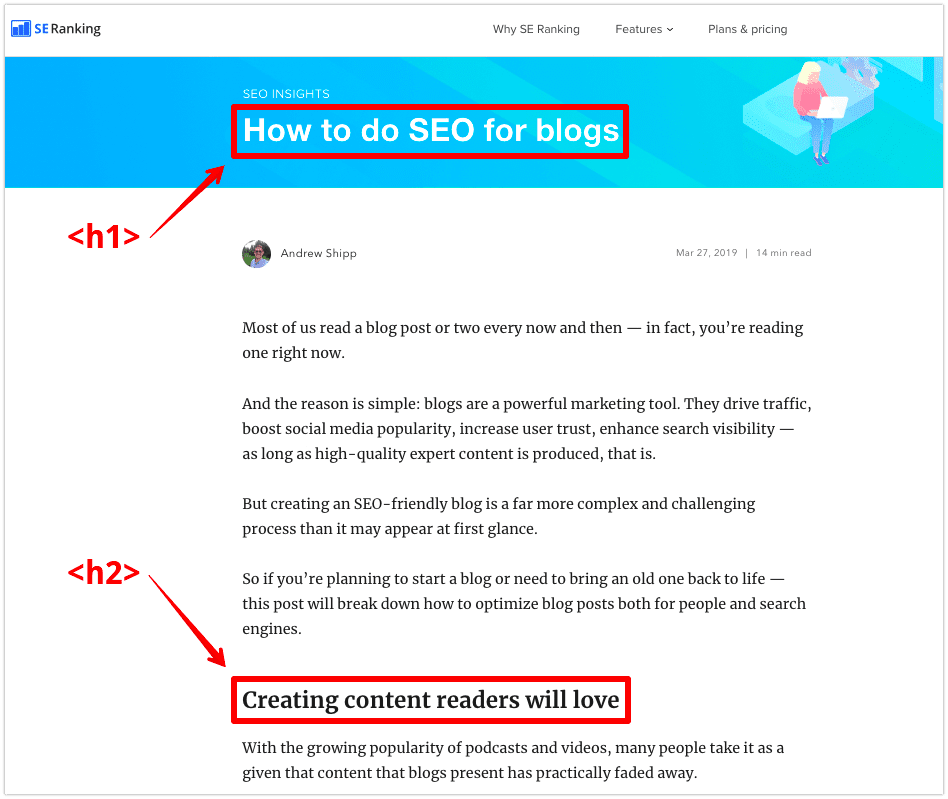


Example (from the image above)
Product H1 tag:
“how to add twitter feed to your shopify store”
Product H2 tag:
“There are two main parts to add a Twitter feed to your shopify store”
Product H3 tag:
“part 1: getting the embed code from twitter”
Target keywords:
“add twitter feed”
“twitter embed code”
“add twitter to shopify”
Note: When writing H tags, make sure you balance keywords and readability. The priority is always readability.
Title tag: Title tag is used on search engines and social media channels to display an accurate and concise description of a page’s content. In the backend, it’s in the form of the following HTML code.
<title>Ergonomic Men’s Red Nike Running Shoes | Awesome Shoes</title>
Search engine



Social media
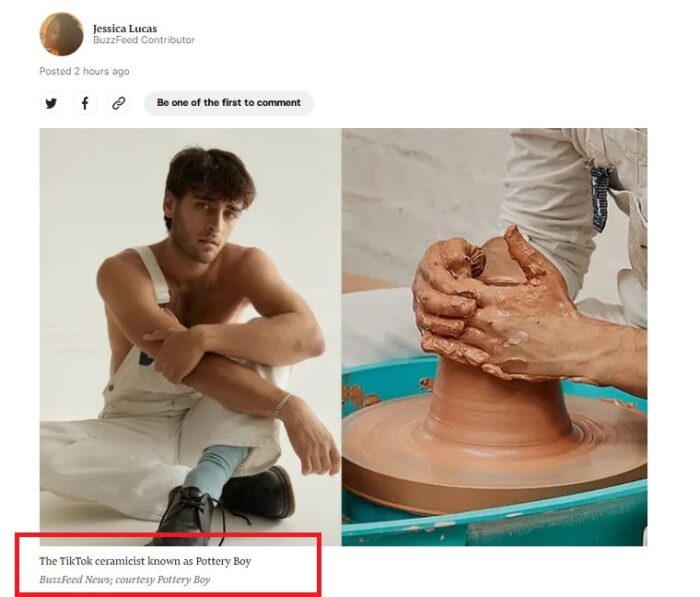
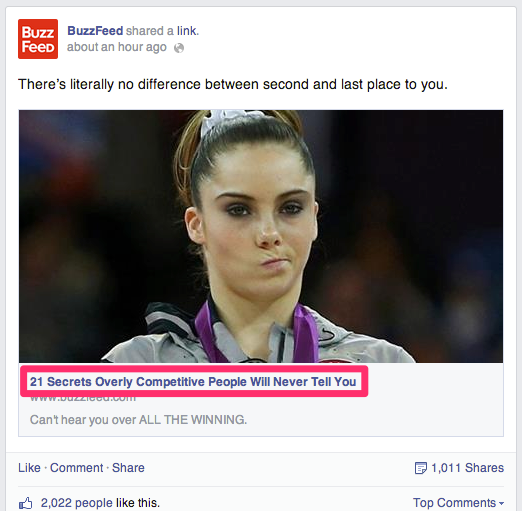

Example
Title tag:
Ergonomic Men’s Red Nike Running Shoes | Awesome Shoes
Target keywords:
“red nike running shoes” “men’s running shoes” “Nike running shoes” “ergonomic running shoes” “ergonomic men’s running shoes”Note: When optimizing title tags, keep them short, concise, and readable..
Page content: When Google crawls your content, it’s intuitive enough to start ranking your site for different combinations of individual words based on topical and brand context. Google puts more emphasis on content closer to the top of the page.
The rule of thumb is to mention a few keywords in the first 100 words of page content. Throughout the rest of the content, make sure you have topical relevance.
Make sure you put priority on readability and provide valuable information. Do not force keywords into places they don’t belong, doing so can trigger over optimization penalty.
Anchor text: When you are linking different pages throughout your site or from another site to your site, you can use anchor text to influence what keywords Google will rank your page.
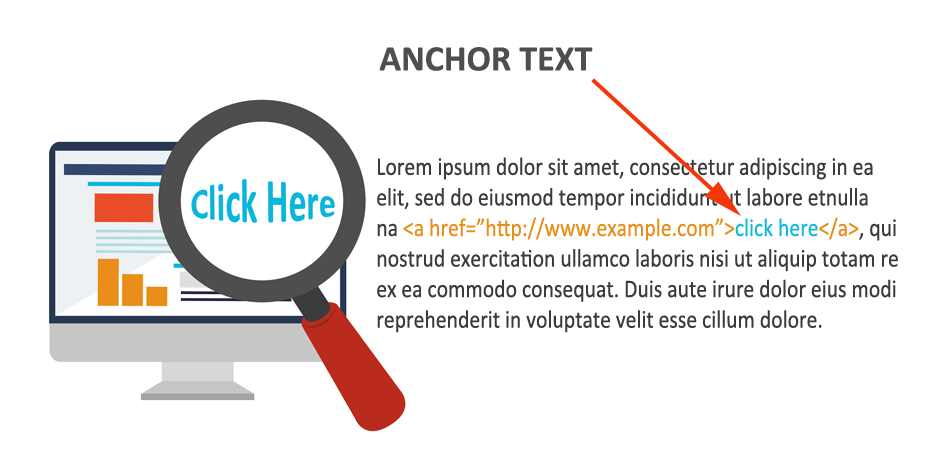


“So this means that I should link different pages with each other and with all the keywords I want to rank for?”
No, it doesn’t. You must keep a balance between different types of keywords. To do this you can use a technique called keyword rotation to rotate between the following types of keywords.
Keyword: “red nike running shoes”
Partial keyword: “shoes that are durable and comfortable”
Brand keyword: “running shoes from AwesomeShoes”
Brand name: “AwesomeShoes”
Naked URL: “www.awesomeshoes.com/red-nike-running-shoes”
Call to action: “click here”
Image ALT tags: Search engines can’t read images, so alt tags are created to describe the images.
When you’re optimizing alt tags, you need to literally describe what the image is and reverse engineer the thought process of a searcher. Ask yourself:
“What would I type into Google image search to find this picture?”
For detailed implementation instructions for Shopify, please read our keyword optimization tutorial.
Optimizing for CTR (Click Through Rate)
Meta Description: The purpose of a meta description isn’t to influence keyword targeting. However, it’s great to get people to click through to your site. Think of meta description as equivalent to ad copy in Google Adwords.
Rich Snippets: Have you ever seen little review graphics next to the results in SERP?
It helps people click through to your site through the results. You can increase CTR as much as 150%.
You can set up rich snippets following the instructions here.
Link Building
Links are arguably one of the most important ranking signals when it comes to Google.
Building relevant links are difficult, and it’s about quality rather than quantity, which has become more obvious every year as Google has worked to put a stop to spam and poor user experiences.
Some of the benefits of links include the fact that they’re permanent and public, so they’re not just going to disappear into obscurity like a social media post.
Links also build your domain authority, particularly when you can get high-quality backlinks. The best links come from sites with high Domain Authority (DA) rankings, and this is a measure of how trustworthy a site is, as well as how popular it is.
Sites with the highest DA rankings are typically considered authority sites, making it difficult to secure a link from them. However, it’s still important to aim for links from sites with good DA rankings, even if they aren’t at the very top of the list.
Link building is considered off-page SEO, so it requires a different level of work than your Ecommerce on-page SEO, and you have less control over it, but considering its importance, it’s worth it for online retailers.
There are several different Ecommerce link building models you might follow.
- One example is working with resource pages to have your links listed. You can do this by reaching out to these sites or submitting your information on their contact pages.
- There are also opportunities that happen when you partner with people who are considered influencers in your niche.
- For example, if you have a clothing website, you might want to work with fashion bloggers who have a similar audience to your targeted audience.
- Links could come from a blog post an influencer writes, or just having a link on one of their own pages. This is where the power of relationship building can come into the equation, or you can work with a professional link builder who can do a lot of this for you.
- Another way to approach Ecommerce link building is by looking for broken links that exist in your niche. You can identify broken links then reach out to the site owner and let them know you have something that would be of interest to their readers.
- Finally, with SEO for Ecommerce, you can also look at your competitors to see where they’re getting links from. Then, reach out to those same places.
Sometimes it can take not just building a relationship, but maybe sending over something for free to build links.
The biggest things to concentrate on with link building for Ecommerce sites include having quality inbound links.
If you have a bunch of low-quality sites linking to your store, it’s not just going to have no effect.
It can have a detrimental effect. You’ll be penalized by Google, and also if you’re getting low-quality links it may increase traffic, but it’s not going to lead to sales.
In some ways, it can be tough to do link building when you’re an Ecommerce retailer, because not a lot of bloggers or publishers are going to be interested in linking to pages of products.
Just like you, they’re focused on quality, so that’s why the next area of this guide is so important, and that’s content creation.
If you have linkable content and informational resources related to your niche, you have something to offer as you build links.
Content Marketing
Content marketing is so important for Ecommerce sites from almost every aspect of business and SEO.
You need great content to drive quality traffic, but you also want to have something to offer an audience aside from your products.
As was touched on above, it’s also excellent for Ecommerce link building when you have valuable content that can be linked to.
Some of the big trends in Ecommerce content marketing right now include:
- Creating a sense of transparency and building a narrative
- Building relationships with influencers and other people who you can turn to as a marketing partner
- Providing an engaging experience for an audience beyond just trying to make a sale
- Creating longer-term relationships with customers
- Providing opportunities to measure your performance and get a better idea of your audience and where you can make changes and tweak your strategies
Of course, Ecommerce content marketing also gives you the chance to continue naturally using your keywords to drive organic traffic.
There is any number of types of content an Ecommerce retailer can start with, even outside of a blog post.
There are e-Books, interviews with someone relevant to your niche, and even video content that creates a story.
Rather than just trying to churn out blog post after blog post, really look at what works and what doesn’t, and think outside the box.
Ideally, with your Ecommerce on-page SEO strategy, you’re going to have each page optimized with a single keyword, so using other types of content gives you the opportunity to expand your use of other important keywords—but as has been touched on throughout this guide, no keyword stuffing.
When you’re doing your keyword research, think about content creation and how your research will feed into that.
Look at forums and other places where you get ideas for keywords. Look at your competitors and see what they’re doing, and use content creation as an opportunity to do something and create a voice that no one else can.
When you’re writing consistent, quality content Google is indexing it and ranking it. Your audience is finding you more often the more content you have, and your rankings go up.
You also have the opportunity not just to increase traffic, but to increase conversions by building a relationship and a sense of trust with your audience.
Also, going back to link building, the more amazing content you have available, the more quality links you’re likely to get back to your site.
Google wants you to keep it fresh. Yes, having some really strong evergreen content is good, but so is setting up an editorial calendar and regularly adding new content.
Ecommerce content marketing isn’t something you can put on autopilot because you need consistency, but what you can do is find what works for you and create templates to make it a faster, easier process over time.
View content marketing as a way to build your authority and integrate it with your SEO strategies, rather than looking at the two concepts separately from one another.
In case you want an example of an Ecommerce site that embraces and maximizes Ecommerce content marketing, Nordstrom is a good one.
They have a wide variety of fashion guides that show you what you need to know to do things like buying the perfect suit.
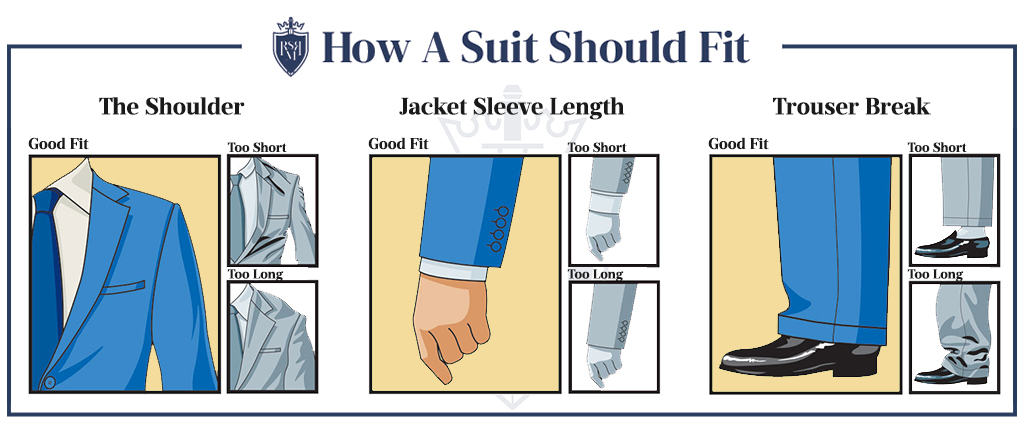
Another prime example is outdoor retailer REI. They have something called the Co-Op Journal, which covers everything from tips on how to become a yogi to stories from real customers who live out their adventure dreams.
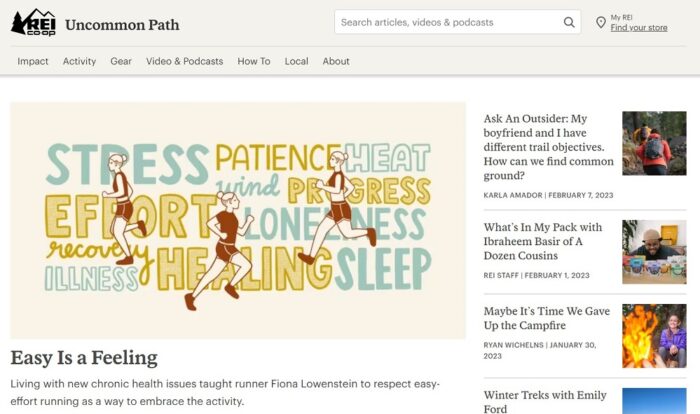
How to Measure It All
Alright, so you’re feeling like you’re ready to dive in and follow everything in this guide.
But, not so fast.
How do you measure it all?
How do you know what’s working and what’s not?
When is it time to make a change?
Analyzing your SEO strategy on a regular basis is so important, but also overlooked.
When you’re going with a PPC strategy, you can look at your Adwords dashboard and instantly see what’s working and what isn’t, but things are as apparent or immediate with SEO.
By and large, Google Analytics offers the best tools to see how you’re doing.
First, you can go to your Channel Grouping report and find your organic search traffic.

You can also use the Assisted Conversions report, which will show you the quality of your traffic. You can compare them month-over-month or in different ways to see if your efforts are leading to an increase in not just your traffic, but your conversions related to traffic.
You’ll consistently want to keep an eye on the speed of your pages loading as well.
You can do a lot with this tool, including signing up to get regular reports by email and seeing things visually with their different graph options.
Regardless of the tools you use, two of the primary things to measure Ecommerce SEO success include increases in traffic from searches, and where search traffic is going regarding landing pages. Then, from there you can look at specific keywords and how you’re ranking.
Measuring the effectiveness of your SEO strategies isn’t always dramatic at first, but is more about long-term trends.
Look for small gains and improvements as signs you’re heading in the right direction.
Content Creation and Social Media
Now that we’ve covered link building, it’s time to cover the role of content and social media in your search rankings.
How does content play a role in your search engine rankings?
Think of content as a form the online currency. The better your content is, the more valuable your site is to visitors, therefore the more valuable your site is to Google.
Google determines the quality of your content by the following factors:
- The word count in your content.
- The digestibility of your content is determined by how far down the page the reader scrolls and how long the user stays on your page.
- Quality and quantity of sites linking to your content (you can get this data with a backlink checker)
- The number of people sharing your content on social media channels. The assumption is that people share valuable content, so if your content isn’t valuable, then no one would care to share it.
Creating great content helps your audience engage on social media, which in turn boosts your search engine value. Think of great content as the glue between social media and search engine traffic.
What counts as good content?
Great content provides your audience with value on different levels:
- Emotions
- Humor
- Awe
- Anger
- Inspiration
- Information
- Become informed
- Get professional advice
- Learn new technical skills
- Find new tools, etc.
You can learn more about how content goes viral here.
How to build a social following from scratch?
Building a following from scratch can be difficult. Use the following tactics to actively boost your following.
- You can reach out to interview other influencers in your niche.
- Guest blog on other sites.
- Allocate some budget to Facebook Ads.
- Reach out to competitors’ following who have been ignored.
- Do tweet chats with niche influencers.
Time to get started!
Ecommerce retailers are facing huge competition just because of the nature of the retail industry, but that doesn’t mean there aren’t still opportunities.
SEO offers the chance to stand out from other retailers, build connections with your customers, increase conversions, and boost revenue, but it’s not a quick fix or something that can happen overnight.
Instead, it’s about building a methodical strategy using tips like the ones above, and finding what works for your site based on SEO best practices.
Keep in mind that as long as you are providing real value and implement everything listed in this SEO guide, then your organic traffic will grow, and so will your sales.
Do you have any thoughts or questions?
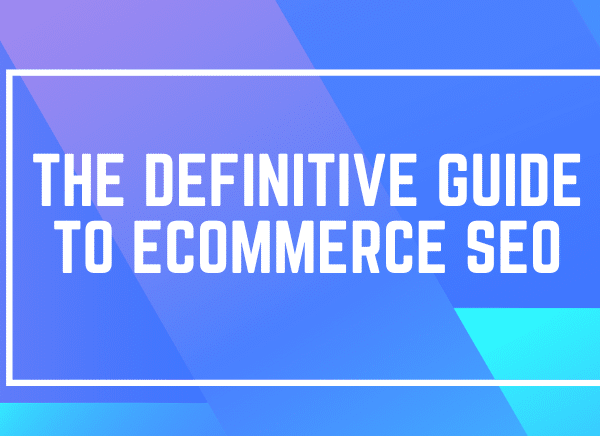
Comments